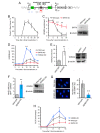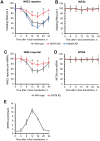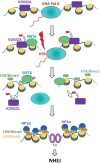SIRT6 mono-ADP ribosylates KDM2A to locally increase H3K36me2 at DNA damage sites to inhibit transcription and promote repair
- PMID: 32584788
- PMCID: PMC7343504
- DOI: 10.18632/aging.103567
SIRT6 mono-ADP ribosylates KDM2A to locally increase H3K36me2 at DNA damage sites to inhibit transcription and promote repair
Abstract
When transcribed DNA is damaged, the transcription and DNA repair machineries must interact to ensure successful DNA repair. The mechanisms of this interaction in the context of chromatin are still being elucidated. Here we show that the SIRT6 protein enhances non-homologous end joining (NHEJ) DNA repair by transiently repressing transcription. Specifically, SIRT6 mono-ADP ribosylates the lysine demethylase JHDM1A/KDM2A leading to rapid displacement of KDM2A from chromatin, resulting in increased H3K36me2 levels. Furthermore, we found that through HP1α binding, H3K36me2 promotes subsequent H3K9 tri-methylation. This results in transient suppression of transcription initiation by RNA polymerase II and recruitment of NHEJ factors to DNA double-stranded breaks (DSBs). These data reveal a mechanism where SIRT6 mediates a crosstalk between transcription and DNA repair machineries to promote DNA repair. SIRT6 functions in multiple pathways related to aging, and its novel function coordinating DNA repair and transcription is yet another way by which SIRT6 promotes genome stability and longevity.
Keywords: DNA repair; SIRT6; genome stability; longevity; transcription.
Conflict of interest statement
Figures





Similar articles
-
PKCδ Regulates Chromatin Remodeling and DNA Repair through SIRT6.Mol Cancer Res. 2024 Feb 1;22(2):181-196. doi: 10.1158/1541-7786.MCR-23-0493. Mol Cancer Res. 2024. PMID: 37889141 Free PMC article.
-
SIRT6 promotes transcription of a subset of NRF2 targets by mono-ADP-ribosylating BAF170.Nucleic Acids Res. 2019 Sep 5;47(15):7914-7928. doi: 10.1093/nar/gkz528. Nucleic Acids Res. 2019. PMID: 31216030 Free PMC article.
-
SIRT6 stabilizes DNA-dependent protein kinase at chromatin for DNA double-strand break repair.Aging (Albany NY). 2009 Jan 15;1(1):109-21. doi: 10.18632/aging.100011. Aging (Albany NY). 2009. PMID: 20157594 Free PMC article.
-
Repairing split ends: SIRT6, mono-ADP ribosylation and DNA repair.Aging (Albany NY). 2011 Sep;3(9):829-35. doi: 10.18632/aging.100389. Aging (Albany NY). 2011. PMID: 21946623 Free PMC article. Review.
-
[A CxxC domain that binds to unmethylated CpG is required for KDM2A to control rDNA transcription].Yakugaku Zasshi. 2015;135(1):11-21. doi: 10.1248/yakushi.14-00202-2. Yakugaku Zasshi. 2015. PMID: 25743893 Review. Japanese.
Cited by
-
Decrease in RNase HII and Accumulation of lncRNAs/DNA Hybrids: A Causal Implication in Psoriasis?Biomolecules. 2022 Feb 25;12(3):368. doi: 10.3390/biom12030368. Biomolecules. 2022. PMID: 35327560 Free PMC article.
-
Sirtuin 6-A Key Regulator of Hepatic Lipid Metabolism and Liver Health.Cells. 2023 Feb 19;12(4):663. doi: 10.3390/cells12040663. Cells. 2023. PMID: 36831330 Free PMC article. Review.
-
The Complex Network of ADP-Ribosylation and DNA Repair: Emerging Insights and Implications for Cancer Therapy.Int J Mol Sci. 2023 Oct 9;24(19):15028. doi: 10.3390/ijms241915028. Int J Mol Sci. 2023. PMID: 37834477 Free PMC article. Review.
-
SIRT6 Through the Brain Evolution, Development, and Aging.Front Aging Neurosci. 2021 Oct 13;13:747989. doi: 10.3389/fnagi.2021.747989. eCollection 2021. Front Aging Neurosci. 2021. PMID: 34720996 Free PMC article.
-
Sirtuin 6 deficiency induces endothelial cell senescence via downregulation of forkhead box M1 expression.Aging (Albany NY). 2020 Nov 10;12(21):20946-20967. doi: 10.18632/aging.202176. Epub 2020 Nov 10. Aging (Albany NY). 2020. PMID: 33171439 Free PMC article.
References
-
- Kakarougkas A, Ismail A, Chambers AL, Riballo E, Herbert AD, Künzel J, Löbrich M, Jeggo PA, Downs JA. Requirement for PBAF in transcriptional repression and repair at DNA breaks in actively transcribed regions of chromatin. Mol Cell. 2014; 55:723–32. 10.1016/j.molcel.2014.06.028 - DOI - PMC - PubMed
Publication types
MeSH terms
Substances
Grants and funding
LinkOut - more resources
Full Text Sources
Medical
Molecular Biology Databases

